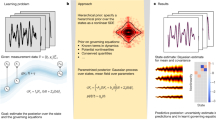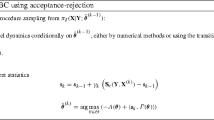Abstract
Assume that in a general state-space model the state transitions p(x t |x t −1) depend on a parameter τ and the observations densities p(y t |x t ) on a parameter η. These can be for instance the noise variances in the state and the observation density, or some parameters related to the mean value of these densities. Both τ and η can be multi-dimensional. The combined parameter (τ′,η′)′ will be denoted by θ. We discuss here the estimation of θ. For state-space models, the Bayesian viewpoint is often adopted and prior distributions for the unknown parameters are introduced. We discuss this approach briefly, but concentrate mainly on the frequentist approach where one has to compute and maximise the likelihood. Exact methods are usually not feasible, but the Monte Carlo methods allow us to approximate the likelihood function.
Preview
Unable to display preview. Download preview PDF.
Similar content being viewed by others
Editor information
Editors and Affiliations
Rights and permissions
Copyright information
© 2001 Springer Science+Business Media New York
About this chapter
Cite this chapter
Hürzeler, M., Künsch, H.R. (2001). Approximating and Maximising the Likelihood for a General State-Space Model. In: Doucet, A., de Freitas, N., Gordon, N. (eds) Sequential Monte Carlo Methods in Practice. Statistics for Engineering and Information Science. Springer, New York, NY. https://doi.org/10.1007/978-1-4757-3437-9_8
Download citation
DOI: https://doi.org/10.1007/978-1-4757-3437-9_8
Publisher Name: Springer, New York, NY
Print ISBN: 978-1-4419-2887-0
Online ISBN: 978-1-4757-3437-9
eBook Packages: Springer Book Archive




